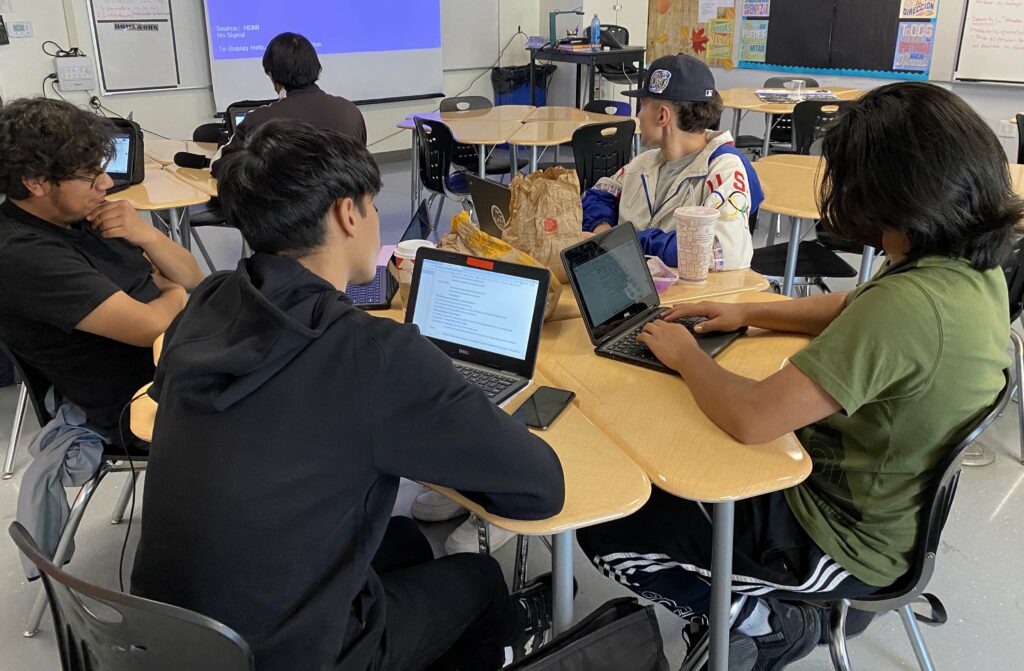Students attend Sociology 101 at Aspire Ollin University Preparatory Academy, one of several dual enrollment classes offered at the school in partnership with East Los Angeles College this semester.
Credit: Kate Sequeira / EdSource
A national report finds that dual enrollment can be a powerful strategy for addressing equity gaps in college enrollment and completion rates, but that the students who most need dual enrollment — Black, Latino and low-income students — still struggle to access it.
The problem of limited access to dual enrollment is true in California, as well as the rest of the nation, according to a report released Monday night by the Community College Research Center (CCRC) at Teachers College, Columbia University.
The study followed students who began taking dual enrollment courses in 2015, typically high school juniors or seniors, through 2021 using data from the National Student Clearinghouse. Researchers say this report is the first look at college outcomes for dual enrollment students after they graduate from high school with results broken down by race, income and gender — at both the state and national level.
This report demonstrates how California’s dual enrollment students fare in college compared with other states through a data dashboard.
For instance, it shows that California students earning college credit in high school are about as likely to enroll in college in the year after high school as other dually enrolled students across the country: 80% compared with 81% nationally. However, dual enrollment students in California are less likely to complete any kind of college degree in the four years after high school: 34% compared to 42% nationally.
According to John Fink, a senior research associate at the Community College Research Center who is one of the report’s authors, the report raises questions about why some states have much stronger outcomes or better access than others.
The report shows that some dual enrollment programs have great outcomes but may not have much access, while others have great access but not great outcomes. The best programs, Fink said, have both — the ability to open the doors widely and offer support to ensure students are successful.
That’s the best way to “fully realize the potential of dual enrollment to broaden college access and attainment and equity,” Fink said.
Caliifornia’s Black, Latino and low-income students in dual enrollment lag behind their counterparts on metrics such as college-going rates or college completion, according to the report. However, these same students are much more likely to do better after high school than those students who are not in dual enrollment.
In California, 25% of Black students in dual enrollment courses were able to attain a bachelor’s degree, compared to 17% of those who had no dual enrollment. Likewise, 20% of Hispanic students in dual enrollment received a bachelor’s degree four years after graduating high school compared to 13% who were never dual enrolled.
Black students tend to be underrepresented in dual enrollment nationally, but nationally the students that do enroll are more likely to attend four-year colleges, enroll in more selective colleges and major in STEM fields, which have high-earning potential.
“The implication is that we need to address the issues around access to dual enrollment for Black students and increase the supports, because we see here what the potential is for increasing postsecondary access and attainment,” Fink said.
The report does not have specific data on why one state might perform better than another, but Fink noted that policies such as charging for classes, requiring certain test scores and other administrative hoops can limit access to dual enrollment for groups who could most benefit.
California was notable in that it relied much more heavily on community colleges for dual enrollment: 87% of its dually enrolled students are taking classes through community colleges compared with 72% nationally.
Students who took dual enrollment courses in California were more likely to continue at a community college after high school, 41% compared to 30% for the rest of the country.
The report found that dual enrollment programs offered by four-year universities tended to have better outcomes, but these institutions under-enrolled Black, Latino or low income students. These programs were more likely to be restrictive and have barriers, such as having more eligibility requirements and not offering transportation.
The year that the study began following students — 2015– was an important one for dual enrollment in California. That was the year the state passed the College and Career Pathways Act, which made it easier for colleges and K-12 schools to work together to expand access to college courses for high school students. The legislation specifically named dual enrollment as a strategy to improve outcomes for students who struggle with academics or are at risk of dropping out.
Dual enrollment more than doubled between 2015 and 2021 in California. Though California is the most populous state, its dual enrollment numbers in 2015 were just a fraction of Texas’. Other states with better developed dual enrollment programs in 2015 include Florida and Ohio.
Fink noted that while a lot has changed in dual enrollment since 2015, research has demonstrated that many of the problems highlighted by this study remain, such as persistent gaps in access for students who are Black, Latino and low-income.
An analysis of data by EdSource in 2022 found that Black and Latino students were disproportionately underrepresented in dual enrollment classes.

